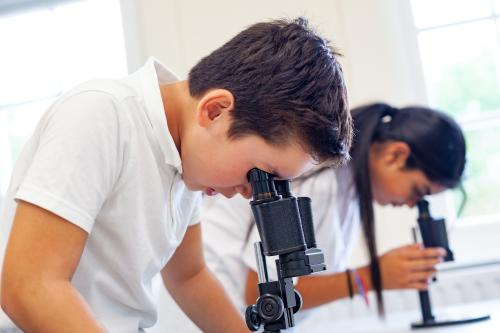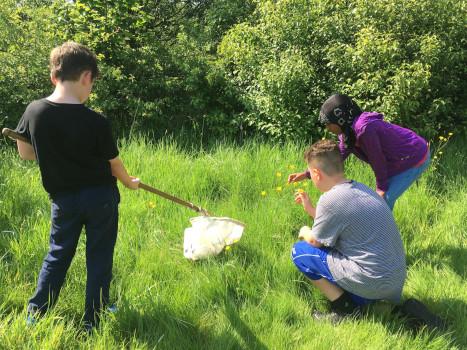

Key stage 2 Science
The Hive science activities allow pupils to learn through exciting first-hand practical experiences, providing opportunities to work scientifically, through scientific enquiry.
If choosing a half day option please choose a second half day from KS2 activities to make your own programme for you day visit.
-
Hive animals - (Indoor activity, available as an outreach visit to your school.) A hands on session with real live animals to explore the characteristics of each of the vertebrate and invertebrate groups & to discover how each animal is adapted through evolution to survive in its habitat. We will also consider the different ways in which their habitats may be under threat. Curriculum links: Science Y3 Animals including humans, Y4, Y5,Y6 Living things and their habitats, Y6 Evolution and inheritance
-
Trees and climate - Explore the trees in the forest to find out about their role in fighting global warming. Find out about photosynthesis, identification, life cycles, pollination, seed dispersal & germination. Undertake some practical measuring to calculate both the age of a tree and to find out how much carbon it is storing. Curriculum links: Science Y5 Living things and their habitats, Y6 Living things and their habitats, Evolution and inheritance
-
Hive eco-trail - Use map skills to undertake an activity trail to learn about the different eco and sustainable features at Hive, including solar panels, ground source heat pump and rainwater harvesting system. Pupils will share what they have learnt and consider how each feature contributes to reducing greenhouse gas emissions. Curriculum links: Geography; Human and physical geography, Geographical skills and fieldwork
-
Energy sustainability day - A day of learning activities about energy including an eco- trail; learning about the sustainable features of the Hive site, and investigations about insulation, solar power and photosynthesis. Students will be asked to make a pledge to take action to combat the climate emergency. Curriculum links: Science Working scientifically, Y6 Electricity. Geography; Human and physical geography, Geographical skills and fieldwork.
-
Water sustainability day - Day of learning activities about water quality and flooding including an eco-trail; learning about the sustainable features of the Hive site, and investigations about how water quality affects biodiversity and Sustainable Drainage Systems (SuDs). Students will be asked to make a pledge to take action to combat the climate emergency. Curriculum links: Science Working scientifically, Y5, Y6 Living things and their habitats, Y6 Evolution and inheritance. Geography; Human and physical geography, Geographical skills and fieldwork.
-
Climate and carbon day - Day where students will study the carbon cycle investigating the relationship between climate change, carbon sinks and trees and the importance of decomposers in the carbon cycle and why it is important to protect biodiversity. Students will be asked to make a pledge to take action to combat the climate emergency. Curriculum links: Science Y5, Y6 Living things and their habitats, Y6 Evolution and inheritance. Geography; Human and physical geography, Geographical skills and fieldwork.
-
Animals with or without bones - (Indoor activity) Develop a respect for animals with this hands on session to investigate vertebrates and invertebrates, using our bone collection and The Hive animals. Curriculum links: Science Y3 Animals including humans
-
Exploring plants in Epping Forest - Enjoy a range of games & activities in the forest, to explore the role plants play in mitigating the climate emergency, while finding out about their different parts and functions and their lifecycles. Curriculum links: Science Y3 Plants
-
Woodland habitats: food chains & classifications - In the woodland habitat of the forest use keys to identify and classify real live invertebrate animals, understand how they fit into a food chain & discover some of the threats to our forest habitats. Curriculum links: Science Y4 Living things and their habitats, Animals, including humans
-
Pond habitats: food chains and classification - (April to October only) In the Hive grounds visit one of our ponds to carefully collect some of the animals living there. Use keys to identify and classify the animals found, understand how they fit into a food chain & discover some of the threats to pond habitats. Curriculum links: Science Y4 Living things and their habitats, Animals, including humans
-
Plant life-cycles in Epping Forest - Explore the plants in the forest, find out about life cycles, photosynthesis, identification, pollination, seed dispersal & germination and their importance in relation to the climate and ecological emergency. Curriculum links: Science Y5 Living things and their habitats
-
Parts of a flower - Use a microscope to observe, identify and record the parts of a real flower e.g. petals, stamen and carpel. Find out about the vital role insects play in pollinating 35% of our food crops. Curriculum links: Science Y3 Plants, Y5 Living things and their habitats
-
Pond habitats: life-cycles - (April - October only) Collect animals from a Hive pond. Observe, identify and group them. Compare life-cycles of amphibians and insects. Threats to forest habitats and on the species found there will be considered in relation to the climate and ecological emergency. Curriculum links: Science Y4 & Y5 Living things and their habitats
-
Pond habitats: adaptation & evolution - (April - October only) Study animals from one of the Hive ponds to discover how real animals are adapted through evolution to their habitat. Curriculum links: Science Y6 Living things and their habitats, Evolution and inheritance
-
Woodland habitats: adaptation & evolution - Through hands on activities in forest woodland, explore how real animals are adapted through evolution to their habitat. Curriculum links: Science Y6 Living things and their habitats, Evolution and inheritance
-
Meadow habitats: adaptation & evolution - (May - September only) Visit a local meadow to explore how real invertebrate animals living there are adapted through evolution to their habitat. Curriculum links: Science Y6 Living things and their habitats, Evolution and inheritance

Fantastic, quick paced and informative day. Very good inclusion (child in wheel-chair). Thank you so much for all your hard work.
